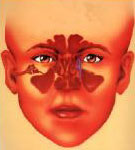| Allergic
Rhinitis (Hayfever) - Your questions answered
For
further help with any allergies problems you may have, click on the
Questionaire links at the bottom of this page.
What is rhinitis?
Rhinitis is defined as inflammation of the lining of the nose, characterised
by one or more of the following symptoms: itching, sneezing, rhinorrhoea
(runny nose) and nasal congestion (blocked nose).
Allergic rhinitis implies that the rhinitis is caused by hypersensitivity
to allergens.
Allergic rhinitis is classified into two types; Seasonal & Perennial
Seasonal allergic rhinitis
Symptoms are usually started by contact with seasonal wind-borne pollens,
e.g. grass and tree pollens or fungal spores. The symptoms usually
occur in spring, early summer and with the change of seasons.
Perennial allergic rhinitis
Symptoms are due to sensitivity to, and contact with, allergens that
are present in the environment throughout the year. These are usually
indoor allergens such as house-dust mite, animal danders (cats and
dogs), feathers, fungal spores and cockroaches.
Is rhinitis serious
Since allergic rhinitis occurs commonly, it is regarded by many as
a trivial illness. But it must be considered as a serious condition
because it can negatively affect the quality of life of sufferers
not only beacuse it may produce severe symptoms, but also because
it may lead to complications. School and work related dysfunction
is common. Sleep disturbances can result in chronic fatigue syndrome
with impacts heavily on the quality of life by resulting in limitations
of activities, emmotional problems and impaired learning abilities
in children.
What can I do about allergic rhinitis?
Rhinitis should be treated by a doctor, who will make a differential
diagnosis based on the clinical history, an examination and allergy
testing. If you have previously been diagnosed by your docotor, you
may discuss symptom relief with your pharmacist.
Your doctor may do certain tests to ascertain the case of the allergy.
If your doctor is able to determine the cause of your allergy, avodance
of the allergen will be part of therapy. Environmental control measures
can improve symptoms and reduce the need for meical treatment, and
should therefore be seen as the primary treatment of allergic rhinitis.
House-dust mite
House-dust mite levels should be measured before any attempt is made
at mite reduction. Where mites are shown to be prevalent and causing
problematic symptoms, the following should be considered:
- Regular damp dusting and vacuum cleaning
- Mattress and pillow covers are effective and cost-effective
- Expose mattresses to sunlight regularly
- Wash mattress covers and linen in hot water (above 60 degrees centegrade)
weekly
- Wooden or tiled floors in the bedroom are preferable to carpets.
Pets
- If possible, remove the pet causing the problem
- Do not allow pets in the bedroom at any time
- Bath pets regularly, including cats.
Irritants
The following often produce symptoms:
-Chlorine in swimming pools - nasal clips are recommended
-Cigarette smoke- the patient 's environment must be smoke-free. Ban
smoking in the house, car and work place.
-Aerosols - deodorants, perfumes, etc.
Medical Treatments
There are many treatments available to control the symptoms of allergic
rhinitis and your doctor will probably perscribe one that is suitable
for your particluar condition.
Treatment options include:topical steroids, topical antihistamines,
anticholinergics and topical nasal decongestants. |
